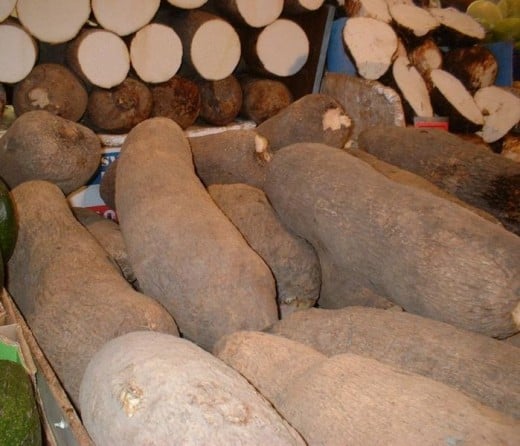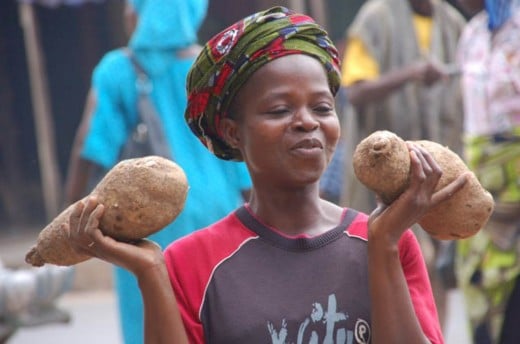What are the Benefits of Yams
Yams and Sweet Potatoes
First, these are two completely different tubers from two completely different plants.
I mention this because many Americans call Sweet Potatoes Yams. This wasn't mistaken identity. In the past there were two varieties of sweet potato grown in the United States. One was rather tough, even after cooking. The other, a hybrid, cooked up quite soft. The soft hybrid is what most people consume in the U.S. today, but to distinguish between the two the term "yam" was applied to the hybrid and the original remained the sweet potato.
The Yam is of the species
Dioscorea; the Sweet Potato is of the species
Ipomoea Batatas. This hub is about Yams.
Where did the Yam Originate
It is relatively certain that Yams were cultivated in West Africa and Asia around 6,000 BCE. The location of the first cultivar is likely in present day Nigeria where the yam still plays an important role in the food supply.
The word "yam" is thought to originate from the Spanish which in turn came from the Wolof language. In Wolof the tuber is called nyam. The word itself means "to sample" or to "taste."
Yams can be stored for up to six months without refrigeration and can be roasted, fried, boiled, grilled, smoked, or shredded and baked.
Yams can grow up to eight feet in length and weigh up to 150 pounds.
Finally, most yams cannot be eaten raw as compounds in the skin of the uncooked yam can cause illness. Even contact with uncooked yams can cause a skin itch which can only be alleviated with a bath.


Nutritional Value of Yam
Yams have high concentrations of vitamin C and B6. They also have a high amount of dietary fiber, potassium, and manganese. They are low in saturated fat and sodium.Of course all of these attributes promote good health.
Unlike potatoes, yams have a lower glycemic index. These means that the energy provided to the human body is sustained as compared to the potato. This, in turn, means that it's a safer form of tuber for diabetics to eat.
Traditional Medicine
Yams have been used, in traditional medicine, to treat asthma, arthritis, diabetes, for pain relief, and for cough.
The Mayans used it to treat menstrual cramps, ovarian and labor pain. The Aztecs used it to treat scabies and boils (likely the skin of the yam was used for this). Pre-American colonists used it to treat epilepsy, morning sickness, hiccough, rheumatism and gastritis.
Chinese medicine used it to treat kidney stones, neuralgia, colic, and irritable bowel syndrome.
Finally, in West Africa, a variety of yam was used as "morning after pill." By having a young woman eat a large quantity of yams it was believed that pregnancy could be prevented.
This knowledge, in the West, lead to the development of the birth control pill.
Modern Medicine
In Hawaiian studies yams have been found to raise good cholesterol. Yam extracts have been shown to reduce blood-sugar levels by up to fifty percent. Yams have also been used in South and Central America for menstrual pain and other reproductive tract disorders.
Because yam
contains dehydroepiandrosterone, a known hormone precursor to estrogen
and progesterone, pregnant women should not eat yam. Mexican grown yam
is the primary source of the artificial corticosteroids which are, in
turn, used to create most steroidal drugs.
Preparing Yams
First, as I usually have a section titled "Choosing..." I'll simply say that with a shelf life of six months in it's natural state any yam you choose at the store is likely safe to eat.
Just cook it first.
As stated above yams can be roasted, boiled, broiled, fried, and even dried in the sun, powdered and the powder used to make a type of porridge.
Less Than Usual Yam Recipes
Smoky Yam Gratin
Ingredients
- 2 Tablespoons butter
- 1 teaspoon minced garlic
- 1 small onion, diced
- 2 Tablespoons all-purpose flour
- 2 smoky chipotles, minced
- 1 1/2 Cups heavy cream
- 1 cup chicken or vegetable stock
- Salt and freshly ground black pepper
- 2 Pounds (about 5 to 7) yams, peeled and cut into 1/4-inch disks
- 8 ounces smoked Gouda, grated
- 1/4 Cup bread crumbs
- 1/4 Cup freshly chopped parsley leaves (or cilantro)
Directions
- Preheat the oven to 325 °F.
- In a small saucepan over medium-high heat, melt the butter and add
the garlic.
- When the garlic has browned, add the onions.
- Cook the onions
until slightly caramelized, about 3 to 5 minutes.
- Stir in the flour and
the chipotles and cook for an additional minute.
- Pour the cream and
stock into the pan and stir.
- Season with salt and pepper, to taste.
- Bring the mixture to a simmer, stirring occasionally.
- Layer about 1/3 of the yam slices in a well greased 11-inch baking
dish.
- Drizzle 1/3 of the cream sauce over the yams and sprinkle some
cheese on top.
- Repeat steps 9 & 10, reserving 1/4 cup of the cheese.
- In a small bowl, mix together the bread crumbs, reserved cheese and parsley. Set aside.
- Cover the yams with foil and bake in the oven for 30 minutes.
- Remove from the oven, discard the foil and top with the bread crumb
mixture.
- Return to the oven for an additional 15 minutes.
- Remove from
the oven and allow to sit for 5 minutes before serving.
- Garnish with chopped parsley and serve.
Yam Pancakes
Ingredients
- 6 Cups all-purpose flour
- 1 1/2 teaspoons baking soda (check expiration date first)
- 3 teaspoons baking powder
- 1 Tablespoon kosher salt
- 2 Tablespoons sugar
- 2 Large eggs
- 1 Cup buttermilk, plus more if necessary
- 2 1/2 Tablespoons vegetable oil
- 1 small pinch ground nutmeg
- 1 small sweet potato, boiled, peeled, and mashed (about 1 1/2 cups)
Directions
- In a large bowl, whisk together the eggs,
buttermilk, and oil.
- Stir in the pancake mix and nutmeg until just
combined.
- Fold* in the sweet potato.
- If the batter seems too thick, add more buttermilk until it reaches the desired consistency (it should be thick but still pourable).
- Place a large, greased griddle or pan over
medium-high heat.
- Working in batches, spoon the batter onto it and cook
until the surface of the pancake is covered with bubbles, 2 to 3
minutes.
- Flip and cook the other side until golden, 1 to 2 minutes more.
- Serve, topped with the honey-cinnamon butter and a little maple syrup.
* Folding is not stirring. To fold add the ingredient to be folded in and press dip your spoon into the mixture as if you were going to spoon it out. Draw the spoon up, to include the new ingredient, and "fold" the combined ingredients over. e.g. turn the spoon over once at the top. Turn the bowl one third rotation and repeat no more than six times. No, the ingredients will not be completely mixed, but that's not what you want anyway.
I usually like making everything myself. For example the recipe above originally called for pre-packaged pancake mix, but it's so easy to make from scratch why buy? The recipe below is one of the exceptions I make. I never make my own pie crust anymore. A good brand is usually cheap enough and well made enough to justify purchasing frozen crusts.
Honestly I can't make it any better than the pasty white dough character.
Pumpkin (Yam) Pie
Ingredients
- 1 Cup heavy cream
- 1 Cup whole milk
- 3 Large eggs plus 2 large yolks
- 1 teaspoon vanilla extract
- 1 (15-ounce) can pumpkin puree
- 1 Cup drained candied yams from 15-ounce can (see note)
- 3/4 Cup sugar
- 1/4 Cup maple syrup
- 2 teaspoons grated fresh ginger
- 1/2 teaspoon ground cinnamon
- 1/4 teaspoon ground nutmeg
- 1 teaspoon table salt
Directions
- Preheat oven to 400° F.
- Let pie crust thaw, but keep chilled.
- Line the crust with foil, and fill
with pie weights or pennies.
- Bake on rimmed baking sheet 15 minutes.
- Remove foil and weights, rotate pie pan, and bake 5 to 10 additional
minutes until crust is golden brown and crisp.
- Remove pie pan and baking sheet from oven.
- Whisk cream, milk, eggs, yolks, and vanilla together in
medium bowl.
- Combine pumpkin puree, yams, sugar, maple syrup, ginger,
cinnamon, nutmeg, and salt in large heavy-bottomed saucepan; bring to
sputtering simmer over medium heat, 5 to 7 minutes.
- Continue to simmer pumpkin mixture, stirring constantly and mashing yams against sides of pot, until thick and shiny, 10 to 15 minutes.
- Remove pan from heat and whisk in cream
mixture until fully incorporated.
- Strain mixture through fine-mesh
strainer set over medium bowl, using back of ladle or spatula to press
solids through strainer. This is optional; I prefer the "lumpy" texture by skipping this step.
- Whisk mixture again and transfer to the warm now pre-baked
pie shell.
- Return pie plate with baking sheet to oven and bake pie for
10 minutes.
- Reduce heat to 300° F degrees and continue baking until edges
of pie are set (instant-read thermometer inserted in center registers
175 degrees) or 20 to 35 minutes longer.
- Transfer pie to wire rack and cool to room temperature, 2 to 3 hours.
Note: The yams give the pie a firmer, better texture than just the pumpkin alone. In other words, a slice of pumpkin/yam pie will retain it's shape far better than a pie made with pumpkin alone. The pie will also have more moisture and more nutrients.










